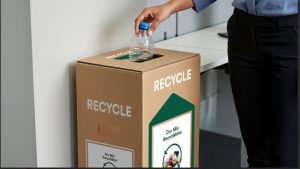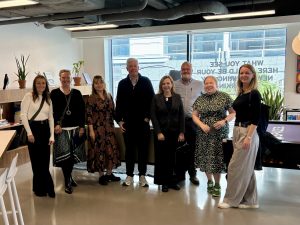How customer-led product innovation fuels SaaS growth – lessons from Peoplesafe
![Will Solomon 2W7A0262[88]](https://smebusinessnews.co.uk/wp-content/uploads/2025/07/Will-Solomon-2W7A026288-scaled-1024x1536.jpg)
Embedding customer feedback into your product roadmap can turn a good SaaS business into a great one. At Peoplesafe, this approach has not only won industry awards, but also unlocked new markets, enhanced customer retention and powered product-led growth.
The company’s CTO, Will Solomon, believes the customer should be at the heart of tech-dev strategy: “Developing a customer-led product strategy will drive retention, so it’s important to embed customer feedback into the technology development roadmap. By building customer-focused software products, a company can successfully enhance customer satisfaction and consequently reduce churn. It also helps launch and monetise new modules to drive upsell and cross-sell that differentiate from the competition.”
Supported by private equity investors, ECI Partners, Peoplesafe is a global provider of workforce safety software products and services for lone and at-risk workers. Through its core protection products, Peoplesafe offers 24/7 protection, 365 days a year for employees of across all sectors, from high-street retail and big corporates through to public organisations, such as the NHS and councils.
The company has developed its platform so that it can quickly roll out new scalable tools that address customer needs and here Solomon shares his insights into how product evolution can drive business growth:
1. Solving customer needs through product development
Understanding customer needs and solving them through technology is the key to any product strategy and the engineering sprints that follow. Customer surveys are a useful way of obtaining direct feedback on new features and iterating based on their feedback, to ensure products are well-received and effective in real-world scenarios.
Solomon comments, “By listening to customers we’ve been able to understand what features are most valuable. Not only does this better service customers, but we’ve also halved the battery consumption of our app by learning how it’s being used. In addition, our clients’ employees were frequently asking if they could use Peoplesafe’s personal protection app for their commute rather than just whilst at work, and several clients ran surveys asking their employees for direct feedback on the new app features. These confirmed concerns around incidents happening on the way to or from work. Our Travelsafe product was therefore designed to help commuters set a destination, then automatically raises an alarm if the journey doesn’t go as expected.”
2. Identifying new vertical sectors to target
Similarly, when identifying new markets to target, it’s important to look for those with specific needs that aren’t currently being met. Naz Dossa, CEO of Peoplesafe, cites the forestry sector as an example: “This is a sector where one of the key challenges for workers is losing signal and therefore the ability to request assistance in the event of an incident. This led to the development of the Peoplesafe’s Roamsafe feature, which uses a second eSIM on the phone so our app can connect to any of the mobile networks available. This improves land coverage from around 83% to around 94%, ensuring the best chance of being able to raise an alarm when needed most. That is key for workers in more remote areas and enables Peoplesafe to operate in certain vertical sectors.”
3. Prioritising your roadmap
Overcomplicating the roadmap is a common pitfall,” says Solomon. “You want to evolve your product without making it hard to sell or use.”
Peoplesafe uses a six-weekly product review board to score new ideas against value, effort and alignment with strategy, avoiding feature complexity and ensuring clarity for engineers and customers alike. Solomon explains, “It’s definitely a choice on value and effort. All feedback and ideas are brought into the product team, where they are assessed for feasibility and market potential and we prioritise opportunities based on our business strategy and goals.”
4. Successfully testing the market
Has your solution answered the customer need you are trying to solve? Product strategy and then development are only the first couple of steps towards successful delivery. Once beta versions of a product are ready, it is important to test that they are working as intended, ideally before the full roll out to the market.
Solomon shares how this works at Peoplesafe: “Because of the modular nature of our app, we can turn on a feature for certain companies as a trial first, often for a subset of their workforce. We can then review employee usage and behaviour, which allows us to see if it really is a solution, before selling it more widely.”
5. Selling benefits to customers
Driving the adoption of new products requires clear communication of their benefits, which can be effectively conveyed through webinars, product information, and marketing campaigns to encourage the use of new product features. Peoplesafe has a very active customer success team that host weekly webinars to highlight how customers can get more value from the product and show what else is on offer.
Modules can also be packaged in ways that make sense, for example if customers adopt the company’s Travelsafe product there is a logic that they might want vehicle crash detection too. Bundles allow a company to create a tailored solution for certain end users. Solomon adds: “A notable example is New Look – they had already adopted personal safety technology to activate audio recording device to capture incidents, with Peoplesafe’s Alarm Receiving Centre listening in and escalating to 999 where needed. The feedback was that their staff were being threatened when they left the stores, on their way home for example, so now they are also rolling out Travelsafe to their staff to provide that additional reassurance.”
6. How new product features can benefit renewals
While new product features allow targeting of new users or markets, they can also transform the renewal process. Without additional features on offer, a renewal conversation can be purely functional or price focused. If you can show new features as part of that discussion, then you can demonstrate improved value for the same price or can upsell additional features that are useful for the customer. Solomon explains: “We look at the data to see if a customer is underusing new features that we believe are relevant to their needs. That way we can deliver early intervention ahead of renewal such as training to drive adoption –ensuring customers are getting value well ahead of that renewal conversation.”
7. Bringing AI into product evolution
AI can be brought into the product evolution mindset, for example Peoplesafe is using it to summarise its very detailed user alarm reports into a short paragraph to save customers time in understanding incident reports and the risks in their employee bases. Solomon explains: “We have a lot of sensitive data, so all AI projects start and end with privacy, which is why hold everything within our internal systems. That data can offer valuable insight, such as high accident or fall locations, to provide better insight for customers in an ethical way.”
Solomon concludes: “Our product roadmap is delivering against two objectives for growth for Peoplesafe. Firstly, we’re able to differentiate against competitors, giving us stickier revenues. Now people are getting more than one service, and that drives better longevity. Secondly, we can address new markets – both in terms of new verticals, but also extension within existing customers.”
With a greater total addressable market, and stickier customers, it’s clear that product evolution is a great driver of growth and business value.
ENDS



